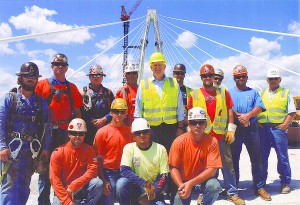
– The Ironworker photos
Union ironworkers from Local 392 (East St. Louis, Ill.) and Local 396 (St. Louis) have completed work on the Stan Musial Veterans Memorial Bridge.
The bridge, dually named after the former St. Louis Cardinals baseball player who died in 2013 and U.S. veterans, becomes the sixth bridge connecting Illinois to Missouri in the St. Louis region and is expected to relieve traffic on nearby bridges, particularly the 50-year-old Poplar Street Bridge, which carries traffic from I-70, I-64, I-55, and US 40 today.
The new bridge reroutes Interstate 70 traffic across the Mississippi River and, while initially it has four main traffic lanes, it is designed with room to add an additional lane in each direction.
THIRD LONGEST CABLE SPAN IN THE U.S.
The bridge’s 1,500-foot span makes it the third longest cable stay bridge in the United States; closely following the John J. Audubon Bridge in Louisiana, and the Arthur Ravenel Bridge in South Carolina. Towering at 400 feet, the bridge is two-thirds the height of the Gateway Arch.
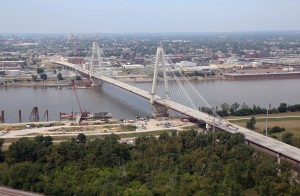
The bridge was a long time in the making with initial designs approved in 2001. Budget difficulties in Missouri and Illinois made it necessary to alter the design with the contract for the main span of the bridge being awarded in 2010.
Illinois contributed $347 million toward the bridge construction, with Missouri contributing $41 million and the federal government contributing $307 million. Part of Illinois’ commitment came from Governor Pat Quinn’s Illinois Jobs Now! capital construction programIllinois Congressman Jerry Costello (D-Belleville) and Illinois State Representative Jay Hoffman (D-Collinsville) were instrumental in securing the funding. The project was built through a joint venture between Massman, Traylor, Alberici (MTA).
STARTED IN 2010
Foundations were started in August of 2010 with the rebar being subcontracted to K. Bates Steel Services. K. Bates Steel Services employed 100 ironworkers at peak, at times working around the clock, seven days a week. There are 9,000,000 pounds of rebar in the two towers and deck alone.
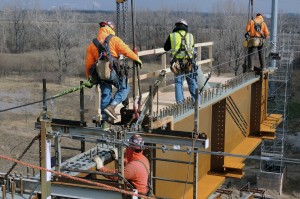
K. Bates’ ironworkers also set and welded the anchorage boxes lining the legs of the towers. These steel boxes served a dual purpose, they were the inside form for the tower legs and also had large frames welded inside to anchor the cables.
In order for the ironworkers to work as safe and efficient as possible, the rebar was tied to the boxes on barges and then lifted into place as a unit. The box-rebar units
ranged from 10 to 19 feet tall and weighed 70,000 to 95,000 pounds.
K. Bates also installed the ladders and platforms inside the tower legs as well as other miscellaneous steel.
Roger Collins, superintendent for K. Bates stated, “I am very proud of the skill and professionalism displayed by
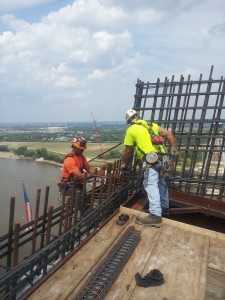
the ironworkers working on the Stan Musial Veterans Memorial Bridge. Their ability to work safely and productively made this a very successful project for K. Bates Steel Services.”
The structural phase of the bridge started nearly two months behind schedule due to flooding on the Mississippi River and poor weather. The first girder was set in May of 2012 and the final piece was set in July of 2013.
Ironworkers from Locals 392 and 396, working for MTA, not only got the bridge back on schedule, but also finished setting the structural steel nearly two months ahead of schedule.
MTA Project Manager Thomas Taverano is quoted as saying, “Iron Worker Local 392 in East St. Louis and Iron Worker Local 396 in St. Louis provided the Mississippi River Bridge project with well-trained workers thus eliminating much of the learning curve typically experienced on this type of project. These skilled workers contributed significantly to the early completion of the project.”
CABLES INSTALLED IN RECORD TIME
Besides the outstanding work setting the structural steel, MTA’s ironworkers installed the cables in record time.
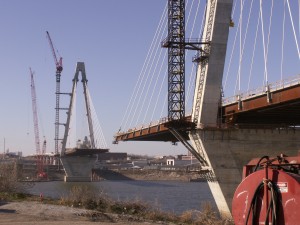
Ironworkers welded 38-foot pieces of HDP pipe together to make the conduits, ranging from 218 to 800 feet long. The conduits were hoisted into place, and then 31 to 73 strands of 5/8 cable were threaded through the conduits and tensioned to complete the cable installation.
In all, it took 3,414,000 feet of cable strand to make the 68 main cables.
Ironworkers completed the cable installation by post-blocking, resin epoxying, and installing the dampeners and anti-vandalism devices on the cables.
MTA’s ironworkers also erected/dismantled the tower cranes, set precast deck panels and installed the guardrail on the bridge. MTA had 54 ironworkers employed at peak.
275,000 MAN-HOURS
There were over 275,000 ironworker man-hours worked on the bridge alone, not counting the extensive approach work on both sides of the river.
If traffic continues to increase, future phases of the project include building a companion bridge. Locals 392 and 396 will continue to train their workers to prepare them to match the success of this project.
(Reprinted with permission from The Ironworker, the official publication of the International Association of Bridge, Structural, Ornamental and Reinforcing Iron Workers.)

